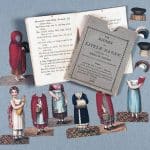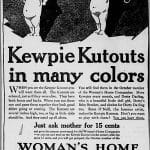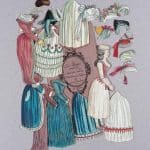by Judy Gonyeau
For many women, their first ideas of fussing over their wardrobe began with paper dolls. From complete outfits and accessories, the idea of mixing and matching to achieve the best look—based upon her own choices—turned many girls to fashionistas.
The paper dolls as we know them today may not be the first known dolls made of paper. These two-dimensional toys became fashion icons, acting as guides to the power of fashion for children and for female members of society.
Dolls made of paper were used as early as 900 AD as part of a Japanese Purification ceremony. The Balinese created shadow puppets from paper in the later years BC. These and many other examples exist throughout history, but do not reflect the costume-changing versions that started in the late 1700s.
Theriault’s Auction House – who deals strictly in dolls and all related items – had the opportunity to showcase a very early example of paper dolls circa 1790 from Germany. Reflecting the fashion of society at the time, “The lady owns four costumes along with five additional skirts allowing a wide variety of costume variations, and 8 different very elaborate hats” according to the item’s auction listing. The gentleman and his costumes included in the lot had a much larger wardrobe, consisting of “seven jackets or greatcoats, one vest, one suit, four pairs of pants, boots, sword, one hat, and three jabots.” This set was hand-drawn and colored, in excellent condition, and sold for $12,000.
While these are not the inexpensive paper dolls produced later in the 1800s and the first half of the 1900s, paper dolls at the time were sometimes used to parody society in many cases. Sometimes jointed and mounted on sticks, they were half puppet/half paper doll (referred to as “pantins” by members of the 18th century French Court) used in jest and providing much entertainment. They were coveted by many who enjoyed the more cynical approach to play.
Buy the Book with Little Fanny
Often noted as the “first” paper doll toy, S&J Fuller of London, England, introduced Little Fanny. As with many early dolls, Fanny came complete with the book The History of Little Fanny and all the outfits she would need to make it from the beginning to the end. A book with the paper doll and her outfits brought $1,000 at Theriault’s. The idea of selling of a book with a toy paper doll quickly caught on in the U.S. when J. Belcher of Boston created The History and Adventures of Little Henry in 1812.
With the growing printing capabilities that came with the Industrial Revolution, specifically chromolithography, it did not take long for McLoughlin Brothers to take on the production of this new toy. They became the largest printer of paper dolls in the U.S., with other printers including Dennison Manufacturing Company and Peter G. Thompson producing additional lines of the popular toy.
Starting in the mid-1800s, newspapers and magazines also printed paper dolls and their accessories; often depicting stars from the world of entertainment and popular figures across time and society including Royalty and icons of industry. Kewpies began as paper dolls before they became porcelain dolls, and Betsy McCall made her debut in the McCalls magazine in 1904, remaining popular through 1926. The Boston Herald printed two lady fashion dolls in the 1890s with the option to purchase more costumes in future issues and through mail order.
The 20th century proved to be a boon for paper dolls, especially during the Great Depression. These inexpensive toys were the answer to the miniscule house-hold budget.
As societal change took place at a record speed, paper dolls kept pace by focusing on women having a career wardrobe, diversity in race and creed, and often reflecting the clothes and accessories only seen on the runway. But paper dolls started to fall out of popularity starting in the 1960s, a decline that is most often blamed on Barbie. According to womenshistory.org, “Today, those dolls and their fashionable paper wardrobes, reflecting the attitudes and assumptions about women’s social roles, tell us a lot in the how the popular culture of fashion defined women.” They are a reflection of the role of women in society over time.
Paper dolls are still available today, with mid-20th century examples being collected as the retro fashion icons they are. Still affordable, buyers can seek them out on most vintage online shops and auctions. Those featuring a special person can command a higher price, such as an uncut Twiggy paper doll set selling on Etsy for $105, or a 1940 Gone with the Wind paper doll set selling for $100 on eBay.
Antique paper dolls from the 19th and early 20th centuries tend to bring a premium depending upon condition and age. A 1902 Dr. Miles Paper Doll is currently selling for $400 at eclectibles.com, and a rare 19th century McLoughlin paper doll is selling at Rubylane.com for $275.










Related posts: